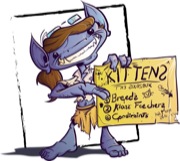| Cronatos |
| 2 people marked this as a favorite. |
I'm in agreement with some of the things already mentioned, and rather than covering old ground, I'm gonna mention some other changes I've been fiddling with - mostly for specific classes of spells.
First, teleportation. I think long-distance teleportation has a place, narratively and mechanically. But as it stands, it is way too easy, too hard to counter, too flexible in application, to the point that it negates a lot of other things that could be interesting (any kind of overland travel, for example). So.
Long-distance teleportation requires three things. A structure, called a waystone; a handheld item, called a keystone; and a teleportation spell.
Waystones are immobile structures. Keystones are attuned to one or more waystones. Holders of keystones can use them to teleport - with a spell/scroll - to any of the attuned waystones over almost any distance. Most major cities have a waystone, and there are other waystones - abandoned or otherwise - scattered throughout the world. Keystones can be attuned to new waystones with a ritual that costs a fair bit in magical materials. Keystones have a limit on how many waystones they can be attuned to, which is determined when they keystone is crafted, and connections can be overwritten. Needless to say, better ones are more expensive.
There are also items called black keystones, that can be used to teleport to any waystone in range. The range on black keystones is usually measured in tens of miles.
Planar travel requires locations where the planes are 'closer'. These locations only allow travel to specific planes, and specific places on those planes. You still need a spell or item for planar travel.
This requirement can be bypassed in two ways. The first is through magical gate structures. Each of these gates is connected to one other gate, and their connections can cross between planes.
The second way is an expensive, time-consuming, inaccurate and one-way ritual. It is ill-advised to use one of these rituals without a way back (usual way is to bring the materials to set up a new gate on the other side, and have the gate it will connect to fully built and ready to go).
Short distance teleportation (Dimension Door) mostly works as-is, but it is medium range (100ft + 10ft/lv) and somewhat inaccurate without line-of-sight.
Edit: forgot a final point: ammunition with the Anchoring enchantment. Anchoring ammunition, when it hits and does damage to a target, binds itself to the target, requiring a high strength check (18ish?) as a standard action to remove. So long as the ammunition adheres to the target (and it's magic is not suppressed), they cannot teleport by any means.
- - - - -
Second subject: shapechanging. I think shapechanging is cool. Some time ago I spent a lot of time thinking about it, and trying to put together a class that can shapechange into anything. Ultimately I decided that would simply be too much. But there are three things that shapechanging can be nice for - espionage, environmental adaptation, combat - and only the last one is really well-represented in class abilities in pathfinder, and I didn't like that. And some classes - notably wizards - had way more flexibility in shapechanging than I thought they really ought to, especially compared to everyone else. Story-time over, now my answer.
Shapechanging is mostly (maybe exclusively) the purview of magical tattoos. Characters can generally have 2 magic tattoos, or spend feats for more. Each tattoo is for a specific form - including appearance stuff like hair color and facial structure. So a character can have a Bear tattoo, which he can activate to turn into a Bear, and activate again to turn back (side-affect of this is that, if the tattoo is suppressed, they can't switch). There is no limit to how long a character can stay in a form granted by a tattoo; they are strictly mode-switch in nature. Druids and other classes with shapechanging abilities get free tattoos and maybe free tattoo slots, rather than their usual abilities (side affect is their number of forms is more limited). Possibly also better ability in tattoo-crafting.
Also note that these may not be literal, actual tattoos - as in, ink under the skin. They are, at the very least, magical, inseparable items that look kinda like tattoos.
Some shape-tattoos are more expensive than others, depending on both how different the given form is from your baseline, as well as how powerful it is in general. Human -> Elf is cheap. Human -> Halfling not quite so cheap. Human -> Bear, bit more expensive. Human -> Fire Giant, possible, but very expensive. You can also get tattoos for the same race/species, but different characteristics. The tattoos can be nearly invisible - almost the same color as the skin it's on - but never entirely invisible.
Tattoos usually cover a small region of the body - forearm or chest, for example. They can be made smaller at greater expense.




